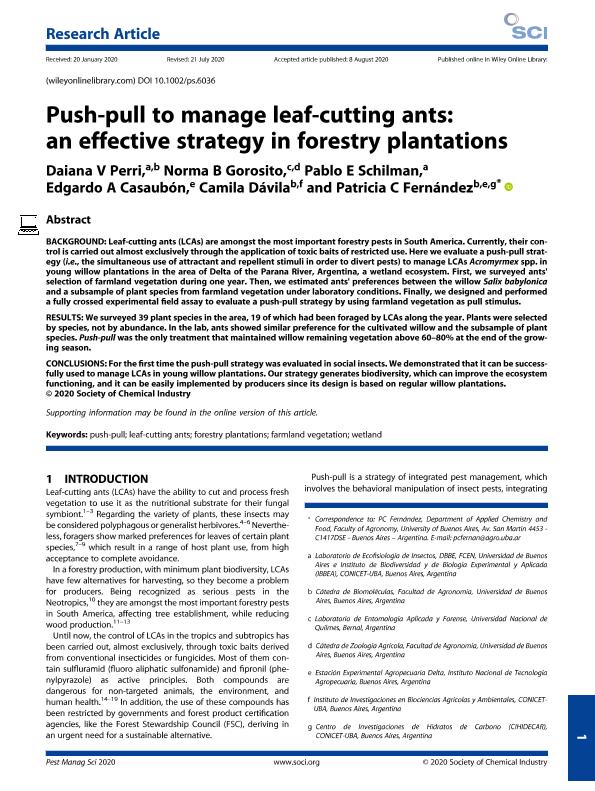Mostrar el registro sencillo del ítem
dc.contributor.author
Perri, Daiana Vanesa

dc.contributor.author
Gorosito, Norma Beatriz

dc.contributor.author
Schilman, Pablo Ernesto

dc.contributor.author
Casaubón, Edgardo A.
dc.contributor.author
Dávila, Camila

dc.contributor.author
Fernandez, Patricia Carina

dc.date.available
2022-01-25T13:40:50Z
dc.date.issued
2020-08
dc.identifier.citation
Perri, Daiana Vanesa; Gorosito, Norma Beatriz; Schilman, Pablo Ernesto; Casaubón, Edgardo A.; Dávila, Camila; et al.; Push-pull to manage leaf-cutting ants: an effective strategy in forestry plantations; John Wiley & Sons Ltd; Pest Management Science; 77; 1; 8-2020; 432-439
dc.identifier.issn
1526-498X
dc.identifier.uri
http://hdl.handle.net/11336/150614
dc.description.abstract
BACKGROUND: Leaf-cutting ants (LCAs) are amongst the most important forestry pests in South America. Currently, their control is carried out almost exclusively through the application of toxic baits of restricted use. Here we evaluate a push-pull strategy (i.e., the simultaneous use of attractant and repellent stimuli in order to divert pests) to manage LCAs Acromyrmex spp. in young willow plantations in the area of Delta of the Parana River, Argentina, a wetland ecosystem. First, we surveyed ants' selection of farmland vegetation during one year. Then, we estimated ants' preferences between the willow Salix babylonica and a subsample of plant species from farmland vegetation under laboratory conditions. Finally, we designed and performed a fully crossed experimental field assay to evaluate a push-pull strategy by using farmland vegetation as pull stimulus. RESULTS: We surveyed 39 plant species in the area, 19 of which had been foraged by LCAs along the year. Plants were selected by species, not by abundance. In the lab, ants showed similar preference for the cultivated willow and the subsample of plant species. Push-pull was the only treatment that maintained willow remaining vegetation above 60–80% at the end of the growing season. CONCLUSIONS: For the first time the push-pull strategy was evaluated in social insects. We demonstrated that it can be successfully used to manage LCAs in young willow plantations. Our strategy generates biodiversity, which can improve the ecosystem functioning, and it can be easily implemented by producers since its design is based on regular willow plantations.
dc.format
application/pdf
dc.language.iso
eng
dc.publisher
John Wiley & Sons Ltd

dc.rights
info:eu-repo/semantics/openAccess
dc.rights.uri
https://creativecommons.org/licenses/by-nc-sa/2.5/ar/
dc.subject
FARMLAND VEGETATION
dc.subject
FORESTRY PLANTATIONS
dc.subject
LEAF-CUTTING ANTS
dc.subject
PUSH-PULL
dc.subject
WETLAND
dc.subject.classification
Otras Ciencias Agrícolas

dc.subject.classification
Otras Ciencias Agrícolas

dc.subject.classification
CIENCIAS AGRÍCOLAS

dc.title
Push-pull to manage leaf-cutting ants: an effective strategy in forestry plantations
dc.type
info:eu-repo/semantics/article
dc.type
info:ar-repo/semantics/artículo
dc.type
info:eu-repo/semantics/publishedVersion
dc.date.updated
2021-04-28T21:33:34Z
dc.journal.volume
77
dc.journal.number
1
dc.journal.pagination
432-439
dc.journal.pais
Reino Unido

dc.journal.ciudad
LOndres
dc.description.fil
Fil: Perri, Daiana Vanesa. Consejo Nacional de Investigaciones Científicas y Técnicas. Oficina de Coordinación Administrativa Ciudad Universitaria. Instituto de Biodiversidad y Biología Experimental y Aplicada. Universidad de Buenos Aires. Facultad de Ciencias Exactas y Naturales. Instituto de Biodiversidad y Biología Experimental y Aplicada; Argentina
dc.description.fil
Fil: Gorosito, Norma Beatriz. Universidad de Buenos Aires; Argentina. Universidad Nacional de Quilmes; Argentina
dc.description.fil
Fil: Schilman, Pablo Ernesto. Consejo Nacional de Investigaciones Científicas y Técnicas. Oficina de Coordinación Administrativa Ciudad Universitaria. Instituto de Biodiversidad y Biología Experimental y Aplicada. Universidad de Buenos Aires. Facultad de Ciencias Exactas y Naturales. Instituto de Biodiversidad y Biología Experimental y Aplicada; Argentina
dc.description.fil
Fil: Casaubón, Edgardo A.. Instituto Nacional de Tecnología Agropecuaria. Centro Regional Buenos Aires Norte. Estación Experimental Agropecuaria Delta del Paraná; Argentina
dc.description.fil
Fil: Dávila, Camila. Consejo Nacional de Investigaciones Científicas y Técnicas. Oficina de Coordinación Administrativa Parque Centenario. Instituto de Investigaciones en Biociencias Agrícolas y Ambientales. Universidad de Buenos Aires. Facultad de Agronomía. Instituto de Investigaciones en Biociencias Agrícolas y Ambientales; Argentina
dc.description.fil
Fil: Fernandez, Patricia Carina. Consejo Nacional de Investigaciones Científicas y Técnicas. Oficina de Coordinación Administrativa Ciudad Universitaria. Centro de Investigaciones en Hidratos de Carbono. Universidad de Buenos Aires. Facultad de Ciencias Exactas y Naturales. Centro de Investigaciones en Hidratos de Carbono; Argentina
dc.journal.title
Pest Management Science

dc.relation.alternativeid
info:eu-repo/semantics/altIdentifier/url/https://doi.org/10.1002/ps.6036
dc.relation.alternativeid
info:eu-repo/semantics/altIdentifier/doi/http://dx.doi.org/10.1002/ps.6036
Archivos asociados
